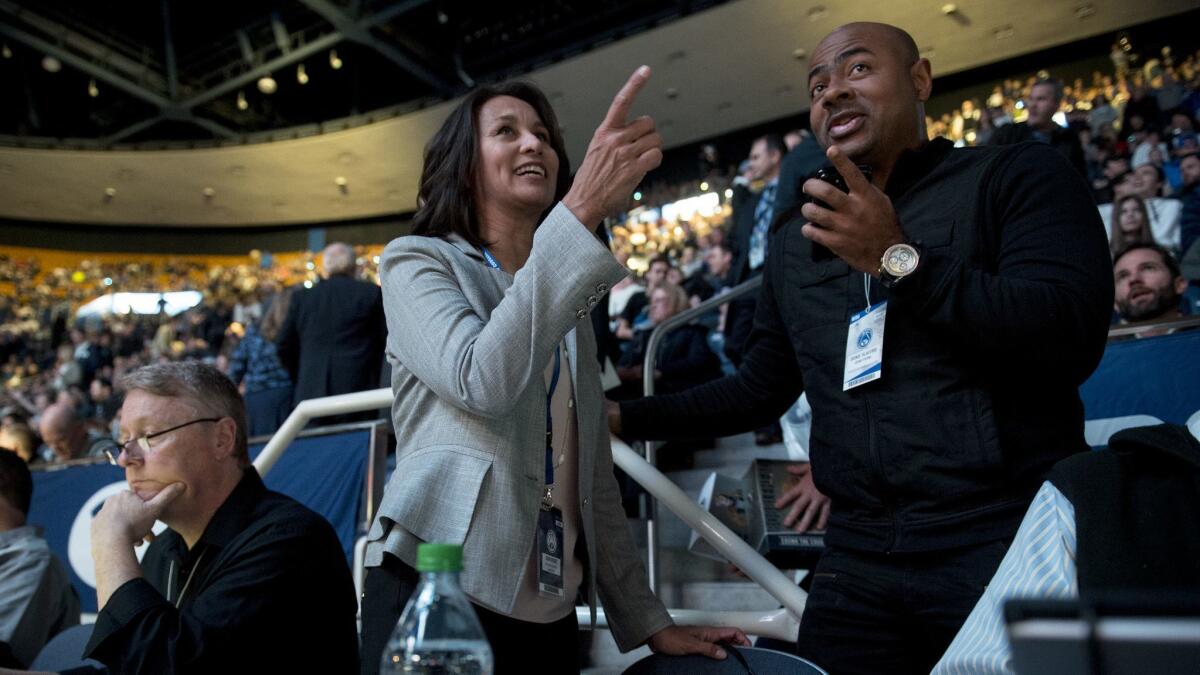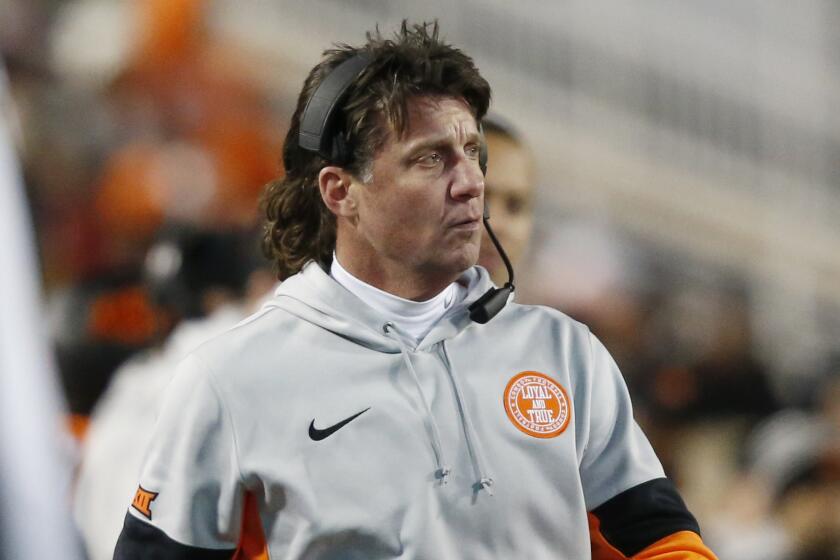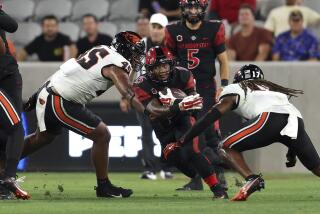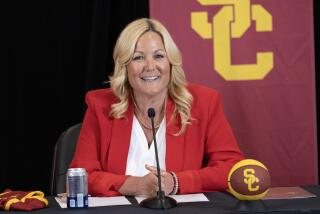Mid-major conferences brace for inevitable cuts in sports budgets because of pandemic

- Share via
West Coast Conference Commissioner Gloria Nevarez sighed out loud at the first mention of this year’s canceled NCAA men’s basketball tournament.
Three months ago, three of her WCC teams were in position to reach the tournament, an accomplishment that would have cemented the league’s flourishing basketball reputation and, just as crucially, bolstered its athletic departments’ bottom lines.
“My password to my computer was ‘2020 Final Four,’ ” Nevarez said with a wishful laugh during a recent phone interview. “I was believing.”
It was a rare opportunity lost to the coronavirus crisis, a chance for the non-football conference to substantially drive revenue from an actual athletic achievement. Instead, it only underlined the huge financial issues facing mid-major conference athletics.
Unlike their Football Bowl Subdivision counterparts, most mid-major schools don’t have massive ticket sales, colossal TV contracts or lucrative sponsorship agreements. While FBS programs need football to balance the books, mid-major schools largely rely on student fees and campus subsidies to fund their athletic departments.
That reality has left mid-major conference administrators across the nation at the whim of factors beyond their control. At non-FBS schools, which account for roughly two-thirds of the NCAA’s 353 Division I members, athletic economic recovery will depend on student bodies returning to campus, not just sports.
Student-athletes at mid-major schools could see their college experience dramatically altered because of the financial losses created by the COVID-19 pandemic.
“The cuts and the decisions that are being made right now in our league ... are very serious and deep,” Nevarez said. “It’s the ripple-through effect of the virus and whether international students come back, whether students who have committed continue to enroll in the fall, and those long-term benefits that impact enrollment.”
Long Beach State athletic director Andy Fee echoed that uncertainty.
“I know we’re going to have to cut some budgets,” he said. “The question for me is, how deep are these cuts going to be?”
When comparing mid-major conference schools without a football program to FBS institutions, Fee isn’t sure who is in a more precarious spot.
FBS schools, he said, “have a mechanism to drive revenue. But the problem is do they have their eggs in one basket? … If that football season doesn’t happen, they’re almost in the same boat as we are. Actually, they might even be in worse shape than us.”
The big difference: It seems like the football season will commence — albeit with limited-capacity or empty stadiums — regardless of whether campuses reopen this fall, allowing FBS programs to potentially collect much of their normal revenue.
At mid-major conference schools, it remains unclear if enrollment totals will drop because of the pandemic, or how student fees could be impacted if the majority of classes are moved online for an entire semester, an arrangement already planned for Cal State schools (the majority of which have non-FBS athletic programs).
Oklahoma State players, including Heisman candidate Chuba Hubbard, are the latest to call for social change after coach Mike Gundy wore a right-wing news outlet T-shirt.
“Let’s say you have a third-less students on campus,” said Karen Weaver, a sports management professor at Drexel and former athletic director of a Division III school in Pennsylvania. “That means your student fees have dried up by a third. What does that mean for athletic department budgets? Does that mean your athletic department budget gets cut by a third? How do you manage that?”
Men’s basketball is often the one sport that can help non-FBS programs generate substantial revenue, particularly through qualification for the NCAA tournament. Every time a team makes March Madness or advances a round, for instance, its conference earns a “unit” to be paid out among its members.
“Basketball is our football,” said Nevarez, who estimates that the cancellation of this year’s tournament cost her conference 60% of its would-be NCAA unit distributions, equating to millions of fewer dollars for its schools. “Distributions we receive from the NCAA for [tournament] participation, that is a big chunk of our operational budget and provides a big influx to our departments that help fund basketball and all other sports.”
But nothing is more important in mid-major conference athletics than main-campus financial support.
Take UCLA, San Diego State and Cal State Fullerton for example. All are public institutions. All are Division I schools. But UCLA and San Diego State, which have FBS programs, are far less financially reliant on their central campus than Fullerton, a non-football school in the Big West.
According to UCLA’s statement of revenue and expenditures for the 2019 fiscal year, less than 3% of the Bruins’ $108.4 million in athletics revenue came from student fees and direct institutional support. (UCLA athletics did need a $18.9-million interest-bearing loan from central campus to cover 2019 losses, the first time in 15 years it failed to balance its budget).
San Diego State, a Mountain West school with less-lucrative but still-significant football earnings, was more split, with about half of its $54.7 million in total 2019 athletics revenue coming from student fees and direct institutional support, according to a 2019 revenue/expense summary reviewed by the Los Angeles Times.
Fullerton, despite fielding generally strong teams in many so-called “non-revenue” sports, leaned on student fees and direct institutional support for more than 76% of its $19.9-million athletics budget in 2019, according to its revenue/expense summary reviewed by The Times.
Replicating those earnings in 2020 will require students being on campus — which remains no guarantee even as the fall semester approaches.
“We understand that we’re not going to get bailed out by the state,” said Fee, who estimates most mid-major conference programs have finances similar to Fullerton. “I can’t stick my hand out to my president and say, ‘Please, just give more, because it’s tough times for athletics.’ ”
If that central-campus money is diminished, it will be the student-athletes who suffer, either through a cut-back in resources or reduction of scholarships altogether.
“The price tag on my worries is different,” Fee said, “but the actual worry is still there.”
Times staff writers Thuc Nhi Nguyen and Ryan Kartje contributed to this report.
More to Read
Go beyond the scoreboard
Get the latest on L.A.'s teams in the daily Sports Report newsletter.
You may occasionally receive promotional content from the Los Angeles Times.












